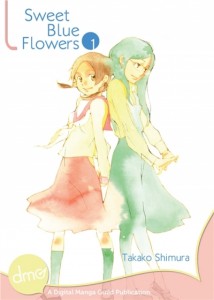By Takako Shimura. Released in Japan as “Aoi Hana” by Ohta Shuppan, serialized in the magazine Manga Erotics F. Released in North America by Viz. Translated by John Werry.
The reason for the somewhat awkward ‘omnibus 1’ up there is that I’ve already reviewed the first volume of this series back in April 2014 when DMP did a somewhat aborted digital release of it. But now we have a handsome paperback of the first two volumes, with a new translation and looking excellent. As for the series itself, it’s odd coming at it now after so many of the series that came after it have done the same thing. The average reader interested in yuri may well ask what they can get from this they aren’t getting from Bloom Into You, or Kiss & White Lily for My Dearest Girl, or even Citrus (well, OK, don’t bring Citrus into this). The biggest answer, of course, is that this is written and drawn by Takako Shimura, and thus is simply well-crafted, with characters whose school days and intimate lives are laid out in sometimes crushing precision by an expert.
One thing that sets this series apart from other ‘girls fall for other girls at a school’ series is that we’re dealing with two different schools. Akira (sailor uniform school) is bright, bubbly, a bit overearnest and not particularly interested in romance at all, at least not at first (though the arranged fiancne of one of her friends seems interested in her). She’s just reunited with childhood friend Fumi (apron-like dress uniform school), who was a big crybaby back in the day and, well, still is. She’s also in love with her cousin, and therefore somewhat devastated when said cousin ends up marrying a guy. She’s quick to rebound, though not with Akira – even though she slowly realizes over the course of the book that Akira was her real childhood crush, she’s now head over heels with Yasuko, who is a charmer and a Takarazuka type if ever there was one. Unfortunately, Yasuko also has issues in her life, namely a crush she used to have on a male teacher. So that’s not likely to work out either.
As you can see, this tends more towards the melodramatic side of the scale, at least when you write out what’s actually going on. As with Shimura’s other classic, Wandering Son, though, it doesn’t feel overwrought as you read it – the emotions feel real without attempting to drown the reader, and everyone reacts (mostly) sensibly. You’ll also note that I mentioned men a few times – even though both schools our heroines attend are girls only, this is not a series where men simply never pop up. And sexuality is not precisely binary either – Yasuko’s somewhat exasperating family note the fact that Yasuko dating Fumi means she’s bisexual now, and we see a few examples of the classic ‘I’m in love with a girl while in school but I will ‘grow up’ and marry a guy’ trope which is, well, very indicative of real life in Japan, though that’s starting to change.
So yes, Sweet Blue Flowers is absolutely worth reading and checking out, both if you like yuri and if you like Takako Shimura. It’s also only four omnibuses, so shouldn’t devastate your bookshelf too much.


